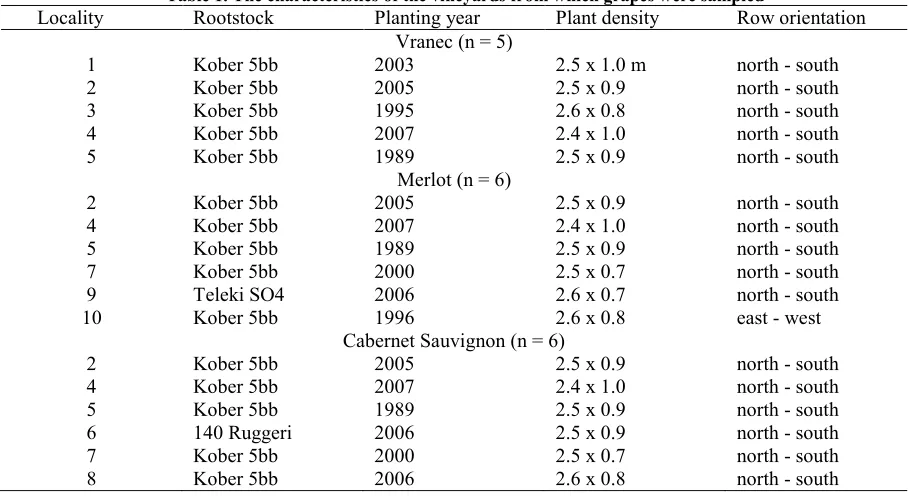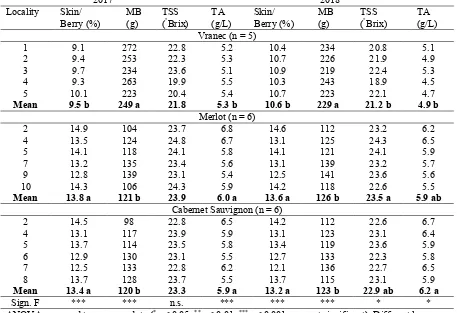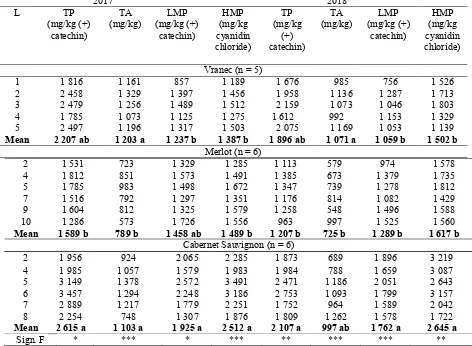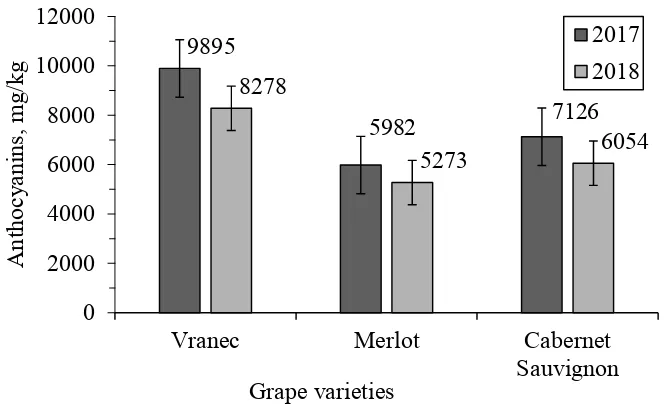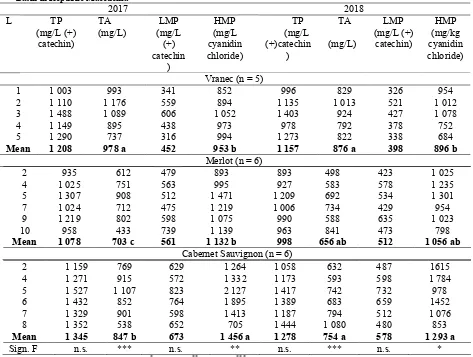IJIRSE/2019/Vol 7. Iss.1/ Page 8
Polyphenolic Characterization of Vranec, Merlot and
Cabernet Sauvignon Grapes and Wines from the Black
River Basin in R. Macedonia
C. Koteski
1, K. Mojsov
2*1
Faculty of tourism and business logistic at University “Goce Delcev”-Stip, R. Macedonia
2*Faculty of Technology, at University “Goce Delcev”-Stip, R. Macedonia, e-mail:
kiro.mojsov@ugd.edu.mk; +38970228128.
Abstract
- In order to characterize polyphenols in tree grape varieties, Vranec, Merlot and Cabernet Sauvignon, grapes were sampled from representative vineyards from Black River Basin at harvest time during 2017 and 2018. On average, the highest content of low-molecular mass proanthocyanidins (LMP), high-molecular mass proanthocyanidins (HMP) and anthocyanins in the year 2017 was found in the Cabernet Sauvignon grapes. The highest content of anthocyanins in the year 2017 and the lowest content of LMP in years 2017 and 2018 was found in Vranac grapes. The highest content of extractable anthocyanins in the skin of grape berries was found in Vranec grapes in 2017 and 2018, followed by Cabernet Sauvignon and Merlot. On average, the Cabernet Sauvignon wines had a higher content of total polyphenols, anthocyanins in 2017 and 2018 respectively, LMP and HMP, compared to the Merlot and Vranec wines. The results obtained are important to better understand the polyphenolic potential of Macedonian red grape varieties in Black River Basin as possibilities and perspectives for the development of tourism.Keywords:
Vranec, Merlot, Cabernet Sauvignon, grape varieties, polyphenolsI. INTRODUCTION
Wine production and growing grape vine in Macedonia goes back to ancient times due to the geographical position and warm climate of the area. Macedonian wines are unique amongst European wines for being made with very little, if any, additional sugar or sulphite preservatives. Preserved mostly by the grapes’own natural sugar, almost all Macedonian wines are dry rather than sweet. Now it is the second most important export agro-food product after the tobacco. In 2010 there were 86 registered wineries in Macedonia with a total capacity of ca. 2 million hL per year and the total capacity of bottling is around 0.65 million hL per year [1]. According to the climate characteristics and classification of the EU, Republic of Macedonia is classified as one geographic area for vine growing (zone III-C-b), that includes three viticultural regions divided into sixteen sub regions with specific favourable natural condition for production of quality wine. Red wine represents approx. 60% of the national production and includes both autochthonous and international grape varieties such as Vranec, Kratosija, Merlot and Cabernet Sauvignon. Vranec is the Macedonia`s best known red grape, that are also cultivated in Montenegro, Bosnia and Hercegovina, Croatia and Serbia and are considered as indigenous varieties of the Western Balkan countries [2]. Vranec grapes are considered to have a strong polyphenol potential [3] and high colour potential [4].
Wine is a complex product composed of various compounds. One of the most important components of red wines that influence their quality parameters are polyphenols. Some sensory attributes such as colour, body, astringency and bitterness are directly associated with the composition of anthocyanins and proanthocyanidins [5]. Anthocyanins are responsible for red colour of wines and proanthocianidins (also known as condensed tannins) for the colour stability, the taste of bitterness and mouthfeel of astringency [6]. Anthocyanins are only present in grape skins whereas proanthocyanidins are present in skins, seeds and stems [7]. The grape phenolic composition and content are affected by several factors such as grape variety, climate, soil, place of growing and vine cultivation, the winemaking techniques, etc. [8].
IJIRSE/2019/Vol 7. Iss.1/ Page 9
The estimation of the polyphenolic potential allows the identification of differences in the polyphenol composition and provides factors with which to evaluate the oenological potential of the grape. There are many publications in which the phenolic composition of wines produced from the international grape varieties Merlot and Cabernet Sauvignon is studied [9, 10] but, there has been almost no detailed research on the phenolic profile of wines obtained from these grape varieties cultivated in Republic of Macedonia. There are also little data on the phenolic composition of Vranec wines which is indigenous Balkan variety [3, 11].
The aim of this research was to characterize Vranec, Merlot and Cabernet Sauvignon grapes from different wine regions in Macedonia according to the extractable polyphenol content of the grape berries. The content of extractable total polyphenols, total anthocyanins, low-molecular mass proanthocyanidins (LMP) and high-molecular mass proanthocyanidins (HMP) have been determined separately in the skin and seeds of grape berries, by using an extraction method that simulates the process of maceration [12]. The same polyphenol groups were evaluated in wines produced from the same grape.
II. EXPERIMENTAL
A. Chemicals and reagents
Ethanol, methanol, sodium hydroxide, sodium bisulphite, hydrochloric acid and L(+)-tartaric acid were purchased from Sigma-Aldrich (St. Louis, MO, USA) and Merck (Darmstadt, Germany). Deionized water was obtained from an ultra pure water system TKA Lab micro (Niederelbert, Germany). The reagents Folin-Ciocalteu and vanillin were from Merck.
B. Grape sampling
Grapes were sampled at the time of their technological maturity, at the end of September in 2017 and 2018. Grape samples of Vranec (n = 5), Merlot (n = 6) and Cabernet Sauvignon (n = 6) were collected from vineyards located in the Black River Basin in R. Macedonia. The characteristics of the vineyards from which grapes were sampled are presented in Table 1. Approximately 50 kg of grapes from each vineyard were representively sampled.
Table 1. The characteristics of the vineyards from which grapes were sampled
Locality Rootstock Planting year Plant density Row orientation Vranec (n = 5)
1 Kober 5bb 2003 2.5 x 1.0 m north - south
2 Kober 5bb 2005 2.5 x 0.9 north - south
3 Kober 5bb 1995 2.6 x 0.8 north - south
4 Kober 5bb 2007 2.4 x 1.0 north - south
5 Kober 5bb 1989 2.5 x 0.9 north - south
Merlot (n = 6)
2 Kober 5bb 2005 2.5 x 0.9 north - south
4 Kober 5bb 2007 2.4 x 1.0 north - south
5 Kober 5bb 1989 2.5 x 0.9 north - south
7 Kober 5bb 2000 2.5 x 0.7 north - south
9 Teleki SO4 2006 2.6 x 0.7 north - south
10 Kober 5bb 1996 2.6 x 0.8 east - west
Cabernet Sauvignon (n = 6)
2 Kober 5bb 2005 2.5 x 0.9 north - south
4 Kober 5bb 2007 2.4 x 1.0 north - south
5 Kober 5bb 1989 2.5 x 0.9 north - south
6 140 Ruggeri 2006 2.5 x 0.9 north - south
7 Kober 5bb 2000 2.5 x 0.7 north - south
8 Kober 5bb 2006 2.6 x 0.8 north - south
C. Determination of grape physicochemical characteristics
IJIRSE/2019/Vol 7. Iss.1/ Page 10
D. Polyphenol extraction from grapesA selective extraction of polyphenols from the skins and seeds of grape berries that simulates the maceration process of red wines was used [14, 15]. Skins and seeds of 200 g of randomly samled grape berries were manually separated and separately extracted for five days at 30°C in a 200 mL solution consisting of ethanol:water (12:88 v/v), 100 mg/L of SO2, 5 g/L tartaric acid and a pH value adjusted to 3.2 with NaOH. Skins and seeds were removed from the hydro-alcoholic solution after five days and the skin extract was centrifuged for 10 min at 3500 g. Extracts were poured into dark glass bottles, flushed with nitrogen and stored at 4°C until required for spectrophotometric analyses. Analyses were conducted three months later.
E. Wine samples. Micro-vinification
Wines were prepared with using a standardised microvinification procedure. The harvestet grapes (50 kg), which originated from different localities, were vinified in the experimental laboratory of IMACO Winery Stip, R. Macedonia, during the 2017 and 2018 seasons. Grapes were processed using commercial grape destemmer/crusher, homogeneously and transferred into stainless-steel fermentation tanks for the maceration and fermentation. The obtained mash was treated with 60 mg/L SO2 (added in a form of 5% sulphurous acid) before inoculation with 200 mg/kg selected yeast (Saccharomyces cerevisiae) NEUTRE SC (Lallemand). Maceration lasted for five days at a temperature between 25 and 28°C. The cap was punched down twice a day until
completion of fermentation. Wines were decanted at the end of alcoholic fermentation and were stored at room temperature. The new wines were inoculated with selected malolactic bacteria (Lalvin) and after malolactic fermentation, the wines were decanted again and treated with 30 mg/L SO2. Polyphenols in wines were analysed
three months after the fermentation. F. Spectrophotometric measurements
Analyses of polyphenols were performed using a spectrophotometer (Cary 50 SCAN, Varian, Inc., USA). All measurements were performed in triplicates.
G. Total polyphenols
The total polyphenols(TP) were determined by the reduction of Folin-Ciocalteu reagent to blue pigments caused by polyphenols in alkaline solution. Other compounds such as sugars, organic acids, amino acids and free SO2, were removed by clean-up of samples (grape extracts and wine) using classic (0.35 g) C-18 columns, that
interfere with the assay [16]. When the absorbance was between 0.3 and 0.6 AU (the linear response range), results were expressed against the corresponding blank as (+)-catechin: 186.5 A d in mg/kg grape fresh mass (FM) or in mg/L of wine; A = absorbance and d = sample dilution.
H. High-molecular mass proanthocyanidins
The content of high-molecular mass proanthocyanidins (HMP) were evaluated by transformation into cyanidin [17]. When the absorbance was between 0.3 and 0.6 AU, results were expressed against the corresponding blank as cyaniding chloride: 1162.5 ΔA d in mg/kg grape FM or in mg/L of wine; ΔA = difference in absorbance between sample and blank, and d = sample dilution. This method provides a good estimation for the evaluation of HMP [18].
I. Low-molecular mass proanthocyanidins – index of vanillin
The content of low-molecular mass proanthocyanidins (LMP) were analysed according to the optimized and controlled vanillin-HCl method of Broadhurst and Jones [19], following the conditions described by Di Stefano et al. [17]. This method provides an estimation of the free carbon 6 and carbon 8 of the A-ring of both catechins and proanthocyanidins. This index decreases with the increase in polymerization, because mainly carbon 6 and carbon 8 are involved in polymerization bonds. When the absorbance was between 0.2 and 0.4 AU, the LMP were evaluated as (+)-catechin = 290.8 ΔA d in mg/kg grape FM or in mg/L of wine; ΔA = difference in absorbance between sample and blank, and d = sample dilution. The method provides a good estimation of free flavanols and a low degree of polymerised flavanols.
J. Total anthocyanins
IJIRSE/2019/Vol 7. Iss.1/ Page 11
using the following equation proposed by Di Stefano et al. [17]: TA = A 16.7 d in mg/kg grape FM or in mg/L of wine as malvidin-3-glucoside equivalents.; A = absorbance at 540 nm, and d = sample dilution.
K. Statistical analysis
For comparison of the means, ANOVA and Tukey`s honest significant difference (HSD) test were applied at the 95% significance level (p ˂ 0.05). Statistical analysis was performed using the Statgraphics Centurion XVI program (Manugistics Inc., USA).
III. RESULTS AND DISCUSSION
A. Physicochemical characteristics of Vranec, Merlot and Cabernet Sauvignon grapes at the time of harvest
The physicochemical characteristics of Vranec, Merlot and Cabernet Sauvignon grapes at the time of harvest from different vineyard locations in the Black River Basin in Republic Macedonia in 2017 and 2018 are listed in Table 2.
Table 2. Phisicochemical characteristics (SKIN/BERRY - percent of skin by berry weight, MB – Mass of 100 berries, TSS – Total soluble solids, TA – Titratable acidity, as tartaric acid) of Vranec, Merlot and Cabernet Sauvignon grapes at the time of harvest from different vineyard locations (L) in the Black River Basin in Republic Macedonia
2017 2018
Locality Skin/ Berry (%)
MB (g)
TSS (°Brix)
TA (g/L)
Skin/ Berry (%)
MB (g)
TSS (°Brix)
TA (g/L) Vranec (n = 5)
1 9.1 272 22.8 5.2 10.4 234 20.8 5.1
2 9.4 253 22.3 5.3 10.7 226 21.9 4.9
3 9.7 234 23.6 5.1 10.9 219 22.4 5.3
4 9.3 263 19.9 5.5 10.3 243 18.9 4.5
5 10.1 223 20.4 5.4 10.7 223 22.1 4.7
Mean 9.5 b 249 a 21.8 5.3 b 10.6 b 229 a 21.2 b 4.9 b
Merlot (n = 6)
2 14.9 104 23.7 6.8 14.6 112 23.2 6.2
4 13.5 124 24.8 6.7 13.1 125 24.3 6.5
5 14.1 118 24.1 5.8 14.1 121 24.1 5.9
7 13.2 135 23.4 5.6 13.1 139 23.2 5.7
9 12.8 139 23.1 5.4 12.5 141 23.6 5.6
10 14.3 106 24.3 5.9 14.2 118 22.6 5.5
Mean 13.8 a 121 b 23.9 6.0 a 13.6 a 126 b 23.5 a 5.9 ab
Cabernet Sauvignon (n = 6)
2 14.5 98 22.8 6.5 14.2 112 22.6 6.7
4 13.1 117 23.9 5.9 13.1 123 23.1 6.4
5 13.7 114 23.5 5.8 13.4 119 23.6 5.9
6 12.9 130 23.1 5.5 12.7 133 22.3 5.8
7 12.5 133 22.8 6.2 12.1 136 22.7 6.5
8 13.7 128 23.7 5.5 13.7 115 23.1 5.9
Mean 13.4 a 120 b 23.3 5.9 a 13.2 a 123 b 22.9 ab 6.2 a
Sign. F *** *** n.s. *** *** *** * *
ANOVA was used to compare data (*p ≤ 0.05, **p ≤ 0.01, ***p ≤ 0.001, n.s. not significant). Different
lower-case letters indicate significant differences of means between varieties using Tukey`s HSD test (p ≤ 0.05).
IJIRSE/2019/Vol 7. Iss.1/ Page 12
(13.4% and 13.2% in 2017 and 2018 respectively) (Table 2). Average TSS content (Table 2) at the time of sampling was the highest in the grape juice of Merlot (23.9°Brix and 23.5°Brix in 2017 and 2018 respectively),
followed by Cabernet Sauvignon (23.3°Brix and 22.9°Brix in 2017 and 2018 respectively). Vranec grape juice reported the lowest TSS values (21.8°Brix and 21.2°Brix in 2017 and 2018 respectively).
The acidity of the grape juice was low, as is typical for warm climates such as the Macedonian region. Significant lower titratable acidity (TA) was assessed in the Vranec grapes (5.3 g/L and 4.9 g/L in 2017 and 2018, respectively) compared to the Merlot grapes (6.0 g/L and 5.9 g/L), even if not significantly different from Cabernet Sauvignon (5.9 g/L and 6.2 g/L).
B. Contents of extractable total polyphenols, low- and high-molecular mass proanthocyanidins and total anthocyanins in grapes of Vranec, Merlot and Cabernet Sauvignon
The content of extractable polyphenols in Vranec, Merlot and Cabernet Sauvignon in the skin and seeds of grape berries at the time of harvest from different vineyard locations in the Black River Basin in Republic Macedonia in 2017 and 2018 is shown in Table 3.
Table 3. Content of extractable polyphenols (TP – total polyphenols, TA – total anthocyanins, LMP – low-molecular mass proanthocyanidins, HMP – high-molecular mass proanthocyanidins) in Vranec, Merlot and Cabernet Sauvignon fresh grape berries from different vineyard locations (L) in the Black River Basin in Republic Macedonia
2017 2018
L TP
(mg/kg (+) catechin)
TA
(mg/kg) (mg/kg (+) LMP catechin)
HMP (mg/kg cyanidin chloride)
TP (mg/kg
(+) catechin)
TA
(mg/kg) (mg/kg (+) LMP catechin)
HMP (mg/kg cyanidin chloride)
Vranec (n = 5)
1 1 816 1 161 857 1 189 1 676 985 756 1 526
2 2 458 1 329 1 397 1 456 1 958 1 136 1 287 1 713
3 2 479 1 256 1 489 1 512 2 159 1 073 1 046 1 803
4 1 785 1 073 1 125 1 275 1 612 992 1 153 1 329
5 2 497 1 196 1 317 1 503 2 075 1 169 1 053 1 139
Mean 2 207 ab 1 203 a 1 237 b 1 387 b 1 896 ab 1 071 a 1 059 b 1 502 b
Merlot (n = 6)
2 1 531 723 1 329 1 285 1 113 579 974 1 578
4 1 812 851 1 573 1 491 1 385 673 1 379 1 735
5 1 785 983 1 498 1 672 1 347 739 1 278 1 812
7 1 516 792 1 297 1 351 1 176 814 1 082 1 429
9 1 604 812 1 325 1 579 1 258 548 1 496 1 588
10 1 286 573 1 726 1 556 963 997 1 525 1 560
Mean 1 589 b 789 b 1 458 ab 1 489 b 1 207 b 725 b 1 289 b 1 617 b
Cabernet Sauvignon (n = 6)
2 1 956 924 2 065 2 285 1 873 689 1 896 3 219
4 1 985 1 057 1 579 1 983 1 984 788 1 659 3 087
5 3 149 1 378 2 572 3 491 2 471 1 186 2 051 2 643
6 3 457 1 294 2 248 3 186 2 753 1 093 1 799 3 157
7 2 889 1 217 1 779 2 251 1 752 964 1 589 2 042
8 2 254 748 1 307 1 876 1 809 1 262 1 578 1 722
Mean 2 615 a 1 103 a 1 925 a 2 512 a 2 107 a 997 ab 1 762 a 2 645 a
Sign. F * *** * *** ** *** *** **
ANOVA was used to compare data (*p ≤ 0.05, **p ≤ 0.01, ***p ≤ 0.001). Different lower-case letters indicate
significant differences of means between varieties using Tukey`s HSD test (p ≤ 0.05).
IJIRSE/2019/Vol 7. Iss.1/ Page 13
Montenegro and Slovenia. Pajovic et al. [20] showed that the mean content of total extractable polyphenols in the skin and seeds of grape berries from different vineyard locations in Montenegro in a two-year study was the highest in Cabernet Sauvignon (2 705 mg/kg and 2 017 mg/kg). Vrhovsek et al. [21] showed that the average extractable total polyphenol content in grapes of red Vitis vinifera varieties grown in Slovenia in a two-year study was between 1 100 and 2 100 mg/kg grape fresh mass (FM), and the highest content was reported in Cabernet Sauvignon (2 000 mg/kg to 2 100 mg/kg). Furthermore, Vranec and Merlot showed a higher amount of total polyphenols compared to some Australian grape cultivars [22].
The mean content of total extractable anthocyanin of the grapes was the highest in Vranec in both years (1 203 mg/kg and 1 071 mg/kg in 2017 and 2018, respectively) and slightly lower in Cabernet Sauvignon (1 103 mg/kg and 997 mg/kg in 2017 and 2018, respectively). Merlot grapes proved to have a significantly lower content of extractable anthocyanins compared to Vranec and Cabernet Sauvignon in both years (789 mg/kg and 725 mg/kg in 2017 and 2018, respectively). The extractable anthocyanin content in Montenegrin red grapes was 960 to 1 113 mg/kg in Vranec, 861 to 1035 mg/kg in Cabernet Sauvignon and 456 to 517 mg/kg in Kratosija [20], whereas in 14 Sardinian red grape varieties the total extractable anthocyanin content ranged from 800 to 2 000 mg/kg [15]. In Vitis vinifera grape varieties, anthocyanins are located mainly in the skin of the grape berries. The highest content of extractable anthocyanins in the skin of grapes (Fig. 1) was found in Vranec grapes (9 895 mg/kg and 8 278 mg/kg skin FM in 2017 and 2018, respectively), followed by Cabernet Sauvignon (7 126 mg/kg and 6 054 mg/kg skin FM) and Merlot (5 982 mg/kg and 5 273 mg/kg skin FM) (Fig. 1). Furthermore, Vranec and Merlot showed also a similar amount of anthocyanins in skins compared to some Italian Merlot grapes analyzed in different seasons [23]. The Macedonian Vranec and Merlot grapes contained a lower amount of anthocyanins, compared to Cabernet Sauvignon and Merlot skin and seed extracts from Bordeaux grapes [24].
9895
5982
7126
8278
5273
6054
0
2000
4000
6000
8000
10000
12000
Vranec
Merlot
Cabernet
Sauvignon
Anthoc
ya
nins,
mg
/kg
Grape varieties
2017
2018
Figure 1. Content of extractable anthocyanins in the skin of grape berries (mg/kg skin fresh mass) of different varieties: Vranec (n = 5), Merlot (n = 6) and Cabernet Sauvignon (n = 6). The error bars represent the standard deviation of the content from different locations from the Black River Basin in Republic Macedonia
IJIRSE/2019/Vol 7. Iss.1/ Page 14
C. Contents of total polyphenols, low- and high-molecular mass proanthocyanidins and total anthocyanins in Vranec, Merlot and Cabernet Sauvignon wines
Contents of total polyphenols, low- and high-molecular mass proanthocyanidins and total anthocyanins in three-months-old Vranec, Merlot and Cabernet Sauvignon wines from different vineyard locations in Macedonian region in 2017 and 2018 are shown in Table 4.
Table 4. Content of polyphenols (TP – total polyphenols, TA – total anthocyanins, LMP – low-molecular mass proanthocyanidins, HMP – high-molecular mass proanthocyanidins) in three-month-old wines from Vranec, Merlot and Cabernet Sauvignon from the 2017 and 2018 vintages from different vineyard locations (L) in the Black River Basin in Republic Macedonia
2017 2018
L TP
(mg/L (+) catechin)
TA
(mg/L) (mg/L LMP (+) catechin
)
HMP (mg/L cyanidin chloride)
TP (mg/L (+)catechin
)
TA (mg/L)
LMP (mg/L (+)
catechin)
HMP (mg/kg cyanidin chloride)
Vranec (n = 5)
1 1 003 993 341 852 996 829 326 954
2 1 110 1 176 559 894 1 135 1 013 521 1 012
3 1 488 1 089 606 1 052 1 403 924 427 1 078
4 1 149 895 438 973 978 792 378 752
5 1 290 737 316 994 1 273 822 338 684
Mean 1 208 978 a 452 953 b 1 157 876 a 398 896 b
Merlot (n = 6)
2 935 612 479 893 893 498 423 1 025
4 1 025 751 563 995 927 583 578 1 235
5 1 307 908 512 1 471 1 209 692 534 1 301
7 1 024 712 475 1 219 1 006 734 429 954
9 1 219 802 598 1 075 990 588 635 1 023
10 958 433 739 1 139 963 841 473 798
Mean 1 078 703 c 561 1 132 b 998 656 ab 512 1 056 ab
Cabernet Sauvignon (n = 6)
2 1 159 769 629 1 264 1 058 632 487 1615
4 1 271 915 572 1 332 1 173 593 598 1 784
5 1 527 1 107 823 2 127 1 417 742 732 978
6 1 432 852 764 1 895 1 389 683 659 1452
7 1 329 901 598 1 413 1 187 794 512 1 076
8 1 352 538 652 705 1 444 1 080 480 853
Mean 1 345 847 b 673 1 456 a 1 278 754 a 578 1 293 a
Sign. F n.s. *** n.s. ** n.s. *** n.s. *
ANOVA was used to compare data (*p ≤ 0.05, **p ≤ 0.01, ***p ≤ 0.001, n.s. not significant). Different lower-case
letters indicate significant differences of means between varieties using Tukey`s HSD test (p ≤ 0.05).
The average content of total polyphenols in the Cabernet Sauvignon wines was higher in both years (1 345 mg/L and 1 278 mg/L in 2017 and 2018, respectively) compared to the Vranec wines (1 208 mg/L and 1 157 mg/L) and Merlot wines (1 078 mg/L and 998 mg/L), although the differences were not statistically significant.
The anthocyanin content was the highest in Vranec wines in both years (978 mg/L and 876 mg/L in 2017 and 2018, respectively) and slightly lower in Cabernet Sauvignon wines (847 mg/L and 754 mg/L in 2017 and 2018, respectively) and Merlot wines (703 mg/L and 656 mg/L in 2017 and 2018, respectively).
The average LMP content was the highest in the Cabernet Sauvignon wines in both years (673 mg/L and 578 mg/L in 2017 and 2018, respectively) and slightly lower in Merlot wines (561 mg/L and 512 mg/L in 2017 and 2018, respectively). The lowest LMP content, although not statistically significant, was found in Vranec wines (452 mg/L and 398 mg/L in 2017 and 2018, respectively).
IJIRSE/2019/Vol 7. Iss.1/ Page 15
2018, respectively), and Vranec wines (953 mg/L and 896 mg/L in 2017 and 2018, respectively). The trend in the polyphenol contents in both years determined in wines was correlated well with the contents found in the grapes (Table 3). Lower contents of LMP were found in wines than in grape extracts, thus concluding that the extraction of LMP was less efficient in vinification than in the grape extraction process.
IV. CONCLUSIONS
Polyphenols play an important role in the organoleptic characteristics of wine. The evaluation of polyphenol compounds in grapes and wines of Macedonian red grape varieties provided a technological characterization that can be used by winegrowers and winemakers. Cabernet Sauvignon and Vranec grapes proved to be highest in extractable total polyphenols during 2017 and 2018. The same trend was also found in wines. Merlot grapes showed lowest polyphenol potential in comparison to Cabernet Sauvignon and Vranec. Vranec grapes and wines showed the highest anthocyanin content that gave the wines an intense red colour. The average LMP and HMP contents in the grape skins and wines were the highest in the Cabernet Sauvignon. The results obtained are important to better understand the polyphenolic potential of Macedonian red grape varieties. All these scientific results will be used as a basis for opportunities and perspectives for tourism development in the Black River Basin.
V. Acknowledgements:
This scientific paper was published as part of the research project “Possibilities and Perspectives for the Development of Tourism in the Black River Basin” funded by Goce Delcev University - Stip, Macedonia (Contract No. 0206-151/16, 545/9 and 0307-98/77 from 01.11.2017) and the Senate Decision No. 0201-922 / 30 of 21 November 2018.
REFERENCES
[1] MAFVE, Ministry of Agriculture, Forestry and Water Economy of Republic of Macedonia. National Strategy for Viticulture and Winemaking for the period of 2010-2015. Macedonia, 2010.
[2] Z. Bozinovic, Ampelografija. Akademik. Skopje, 2005.
[3] V. Ivanova, M. Stefova, B. Vojnoski, A. Dörnyei, L. Márk, V. Dimovska, T. Stafilov, F. Kilár, Identification of polyphenolic compounds in red and white grape varieties grown in R. Macedonia and changes of their content during ripening. Food Res. Int. 44, 2851-2860, 2011.
[4] L. Avramov, L., Vinogradarstvo. Nolit, Beograd, 1991.
[5] S. Vidal, L. Francis, S. Guyot, N. Marnet, M. Kwiatkowski, R. Gawel, V. Cheynier, E. J. Waters, The mouth-feel properties of grape and apple proanthocyanidins in a winelike medium. J. Sci. Food Agric. 83(6), 564-573, 2003.
[6] J. L. Robichaud, A. C. Noble, Astringency and bitterness of the selected phenolics in wine. J. Sci. Food Agric. 53, 343-353, 1990. [7] P. Ribereau-Gayon, Y. Glories, A. Maujean, D. Dubourdieu, The chemistry of wine stabilization and treatments. In: Handbook of
enology, vol 2. Wiley, Chichester. pp. 232-234, 2000.
[8] F. Mattivi, U. Vrhovsek, D. Masuero, D. Trainotti, Differences in the amount and structure of extractable skin and seed tannins amongst red grape varieties. Aus. J. Grape Wine Res. 15, 27-35, 2009.
[9] G. González-Neves, J. Franco, L. Barreiro, G. Gil, M. Moutounet, A. Carbonneau, Varietal differentiation of Tannat, Cabernet-Sauvignon and Merlot grapes and wines according to their anthocyanic composition. Eur. Food Res. Technol. 225, 111-117, 2007.
[10] M. J. Aguirre, M. Isaacs, B. Matsuhiro, L. Mendoza, L., L. S. Santos, S. Torres, Food Chem. 129, 514-519, 2011.
[11] A. Radovanović, B. Radovanović, B Jovančićević, Free radical scavenging and antibacterial activities of southern Serbian red wines. Food Chem. 117, 326-331, 2009.
[12] F. Mattivi, C. Zulian, G. Nicolini, L. Valenti, Wine, biodiversity, technology, and antioxidants. Ann. N.Y. Acad. Sci. 957, 37-56, 2002.
[13] OIV (International Organisation of Vine and Wine), Compendium of international methods of wine and must analysis, vol 1. International Organisation of Vine and Wine, Paris, 2011.
[14] F. Mattivi, A. Prast, G. Nicolini, L. Valenti, Validazione di un nuovo metodo per la misura del potenziale polifenolico delle uve rosse e discussione del suo campo di applicazione in enologia. Riv. Vitic. Enol. 2/3, 55-74, 2002.
[15] V. Vacca, A. Del Caro, G. G. Millela, G. Nieddu, Preliminary characterisation of Sardinian red grape cultivars (Vitis vinifera L.) according to their phenolic potential. S. Afr. J. Enol. Vitic. 30, (2), 93-100, 2009.
[16] R. Di Stefano, S. Guidoni, S., The analysis of total polyphenols in musts and wines. Vignevini 1/2, 47-52, 1989. [17] R. Di Stefano, M. C. Cravero, N. Gentilini, N., Methods for the study of wine polyphenols. L’Enotecnico 5, 83-89, 1989. [18] U. Vrhovsek, F. Mattivi, A. L. Waterhouse, Analysis of red wine phenolics: comparison of HPLC and spectrophotometric
IJIRSE/2019/Vol 7. Iss.1/ Page 16
[19] R. B. Broadhurst, W. T. Jones, W.T., Analysis of condensed tannins using acidified vanillin. J. Sci. Food Agric. 29, 788-794, 1978.
[20] R. Pajovic, D. Radicevic, T. Popovic, P. Sivilotti, K. Lisjak, A. Vanzo, Polyphenolic Characterisation of Vranac, Kratosija and
Cabernet Sauvignon (Vitis vinifera L. cv.) Grapes and Wines from Different Vineyard Locations in Montenegro. S. Afr. J. Enol.
Vitic. 35, 139-148, 2014.
[21] U. Vrhovsek, A. Vanzo, B. Koruza, Z. Korosec-Koruza, Polifenolni potencial slovenskega rdecega grozdja. [Polyphenol potential of Slovenian red grapes]. In: M. Puconja, (ed). Vinogradi in vina za tretje tisocletje. Otocec, Slovenia. pp. 359-367, 2002.
[22] T. J. Seddon, M. O. Downey, Comparison of analytical methods for the determination of condensed tannins in grape skin. Australian Journal of Grape and WINE Research 14, 54-61, 2008.
[23] B. Buccherttia, M. A. Matthews, L. Falginella, E. Peterlungera, S. D. Castellarin, Effect of water deficit on Merlot grape tannins and anthocyanins across four seasons. Scientia Hortculturae 128, 297-305, 2011.
